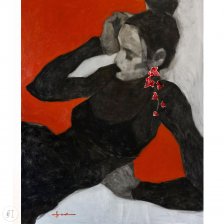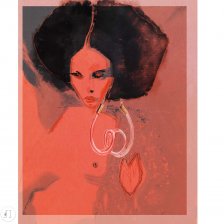МEMORIES AND DREAMS PAINTED ON WOOD: AN INTERVIEW WITH GLADYS BONNET
It is the tool that makes you share inexpressible emotions out of yourself.
Gladys Bonnet
The wooden canvases of Gladys Bonnet are a portal to a world suspended between dreams and reality, memory and imagination, and the raw beauty of nature itself.
Her brushstrokes are a duel with the ephemeral, a struggle to pin down the fleeting shadows of her dreams and the elusive faces of her memories, not as a quest for perfection but as a perpetual trip back and forth into the unknown reaches of her own psyche.
For Gladys, the act of painting is akin to conjuring visions from the ether, giving form to that which defies articulation, and inviting the viewer to wander through the labyrinthine corridors of her imagination.
In this enchanted world, Bonnet embraces the vulnerability that comes with baring one's soul on the canvas, understanding that art, in its purest form, is a mirror to the artist's heart, reflecting the myriad emotions, fears, and aspirations that dwell within.
Read the full interview with Gladys Bonnet and savor her curious story.
To me, painting is a constant battlefield. And even when it’s finished, I always tell myself that I could have done more.
Gladys Bonnet
The JI: What are these places that you paint? Do they come from your dreams? From something that you have seen in real life, and then translate into a painting? Stories that you've heard? Books that you've read or movies that you've seen?
Gladys Bonnet: It’s a mix between my memories, my dreams and my imagination. I also hike every week in the mountains, and this is where I get most of my landscape inspiration, but not directly.
I refuse to paint from the pictures that I take in these places. I paint what comes from my mind and I don’t sketch a lot.
The JI: What answers are you expecting to find while painting and through your paintings?
Gladys Bonnet: For me, painting is a constant battlefield. And even when it’s finished, I always tell myself that I could have done more.
I don’t think I am a good painter, by the way. I am always learning. But I know one thing: that I will never be done with it. I am not ever sure about what I’m looking for, but I have ideas that I put on paper and then I paint them, spontaneously.
I know that I am trying to create a world of its own, ruled by the uncanny, the fantastic and by symbolism. My work is thought through over a period of time. I’m bad at telling linear stories, so I paint them for what they are: visions.
My parents are not in the artworld, but I grew up with Dali’s lithographs on the walls. In high school, I had the chance to see with my own eyes The Fall of the Damned by Peter Paul Rubens. It was a slap in my face.
Gladys Bonnet
The JI: What art inspires you?
Gladys Bonnet: Okay, let me tell you a little story. My mom had in storage a series of books from Larousse. One of them was about the history of art, with a painting by Goya that triggered me at that time: Saturn Devouring One of his Sons
I might have been seven at that time. I think that is the first artwork that made me feel such a strong emotion.
My parents are not in the art world, but I grew up with Dali’s lithographs on the walls. In high school, I had the chance to see with my own eyes The Fall of the Damned by Peter Paul Rubens. It was a slap in my face.
When I began my studies, I discovered Olivier Masmonteil’s artwork, and I had the chance to be one of his interns, in his studio, for a short period of time.
When I was at the Royal Academy of Brussels, I went a few times to the Fine Art Museum of the city and around, to watch very closely the details of the old Flemish masters, in particular Bruegel, Mantegna, and John Martin at the Louvre.
Now I am looking at the works of Oda Iselin Sønderland, Jean-Baptiste Boyer, Aron Wiesenfeld, Sophie Varin, Carole Mousset and Leonora Carrington.
The JI: What’s the most ridiculous, funniest misconception about being an artist?
Gladys Bonnet: That artist is not a real job.
The JI: What is your life philosophy? And how does it influence your artistic expression?
Gladys Bonnet: Eco-anxiety.
I don’t think what I'm going to say now is life philosophy, but I don’t think I am going to die in a peaceful way. And, to be honest, I've been pretty scared of it since I was little. Each year, at my individual scale, I see the changes of climate change. Maybe painting is a way to leave a little trace for the world that I won’t see. I know, it sounds very clichéd.
It is true that, when you begin to make art in a serious way, you’re worried about it. But what this feeling is really saying about you is that you’re scared to be judged for who you really are.
Gladys Bonnet
The JI: Art is a very personal affair. Through art we reveal our innermost perceptions about the world, people, feelings, justice, ourselves. How do you deal with vulnerability in sharing your personal experiences or thoughts through your paintings?
Gladys Bonnet: I am playing with the viewer through this. What I’m trying to do is to find the best way to communicate something that you can’t put your finger on.
The paintings that I’ve made carry the state of mind that I had when I made them.
It is true that when you begin to make art in a serious way, you’re worried about it. But what this feeling is really saying about you is that you’re scared to be judged for who you really are. Some of my colleagues were scared to be emotionally touched by the critics when their works were too personal. It’s normal to wish to be accepted by your peers.
For my part, I had a perverted relation with it: when I was in art school, I self-sabotaged my works (I didn’t take care of them) to be emotionally detached from them. Each year, I threw away half of them.
Now I try to learn to love them and treat them like my little babies.
Artists are in the little window between the white page and the pitch black one; and they play with it.
Gladys Bonnet
The JI: For many people, art is associated with extreme emotions and experiences. Do you think suffering or hardship is necessary to create? What are your driving emotions in the process of creation?
Gladys Bonnet: In Art As Experience by John Dewey, he says: "Factors that are discouraging to a child or person who does not have a solid background of comparable experiences are an incentive, for them who have had the experience of similar situations from which they can draw inspiration, to use intelligence to reorganize and convert emotion into interest.”
What I understand about this is that, yes, strong emotions, such as pain, are a necessity to create. Creation is the decoction of that process.
I think that to be an artist, you need this. But if it has affected you too much, you will take refuge in something else.
Artists are in the little window between the white page and the pitch black one; and they play with it.
Concerning AI: I am not scared of it. It doesn’t have any personality. When you see AI-generated pictures, they all look the same.
Gladys Bonnet
The JI: In our time, many things can be done through technological tools (apps, AI, etc.). How do you see these tools existing in the same world as an artist?
Gladys Bonnet: Right now, I am making some tests with digital painting, and I like it. I am fascinated by the ones who master this art, like Juan Miguel López Barea.
Concerning AI: I am not scared of it. It doesn’t have any personality. When you see AI generated pictures, they all look the same. I would be worried about the day when it starts to have a conscience, but the creators would destroy it in this case, so…
It looks like the real world, paint made from real substances is our firewall against this.
Of course, I am talking, for my part, as an oil painter. So it’s very easy to say: “I am not scared”. But, unfortunately, it will destroy opportunities and jobs.
The JI: What is the place where you like to create your art? Where do you get comfortable, inspired, eager to create?
Gladys Bonnet: My studio, which is also my room for now. It took a while for me to feel comfortable in this place. It’s not made for it, but I have personalized it.
Now I know that my desk looks like my mind, and I'm bringing out the best of it.
When I need to be alone, I go to the observatory of Caussols. When I was little, I wanted to be an astronaut, so I visited it a few times, and I know how it looks inside. Now I sit and I watch this very dreamy place.
Gladys Bonnet
The JI: In your town, where you live and where you create, what is your:
- favourite place to eat?
I love to eat when I’m hiking, looking at the horizon.
- favourite place to meet your friends?
I love the stone beach to meet my friends. It has always been a synonym of a happy place for me.
- favourite place to be on your own, for some precious me time?
Gladys Bonnet: When I need to be alone, I go to the observatory of Caussols. When I was little, I wanted to be an astronaut, so I visited it a few times, and I know how it looks inside. Now I sit and I watch this very dreamy place. In the middle of the night, you can easily see shooting stars there.
The JI: What is art for you?
Gladys Bonnet: It is the tool that makes you share inexpressible emotions out of yourself.
The JI: What is love for you?
Gladys Bonnet: I am too young to answer this question.
The JI: What is freedom for you?
Gladys Bonnet: In our world? Money.























